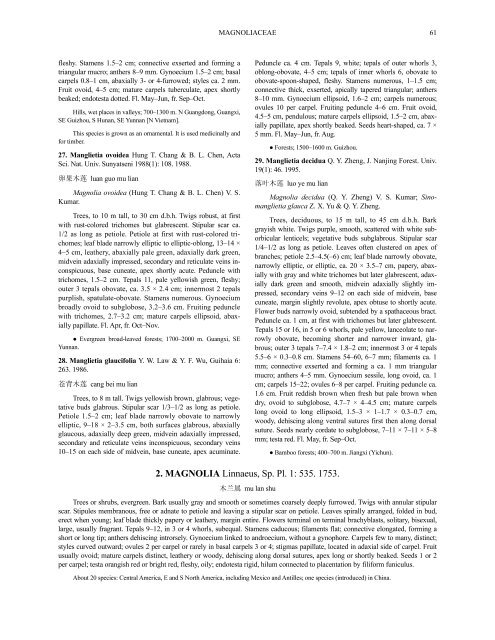Magnoliaceae (PDF)
Magnoliaceae (PDF)
Magnoliaceae (PDF)
You also want an ePaper? Increase the reach of your titles
YUMPU automatically turns print PDFs into web optimized ePapers that Google loves.
fleshy. Stamens 1.5–2 cm; connective exserted and forming a<br />
triangular mucro; anthers 8–9 mm. Gynoecium 1.5–2 cm; basal<br />
carpels 0.8–1 cm, abaxially 3- or 4-furrowed; styles ca. 2 mm.<br />
Fruit ovoid, 4–5 cm; mature carpels tuberculate, apex shortly<br />
beaked; endotesta dotted. Fl. May–Jun, fr. Sep–Oct.<br />
Hills, wet places in valleys; 700–1300 m. N Guangdong, Guangxi,<br />
SE Guizhou, S Hunan, SE Yunnan [N Vietnam].<br />
This species is grown as an ornamental. It is used medicinally and<br />
for timber.<br />
27. Manglietia ovoidea Hung T. Chang & B. L. Chen, Acta<br />
Sci. Nat. Univ. Sunyatseni 1988(1): 108. 1988.<br />
卵果木莲 luan guo mu lian<br />
Magnolia ovoidea (Hung T. Chang & B. L. Chen) V. S.<br />
Kumar.<br />
Trees, to 10 m tall, to 30 cm d.b.h. Twigs robust, at first<br />
with rust-colored trichomes but glabrescent. Stipular scar ca.<br />
1/2 as long as petiole. Petiole at first with rust-colored trichomes;<br />
leaf blade narrowly elliptic to elliptic-oblong, 13–14 ×<br />
4–5 cm, leathery, abaxially pale green, adaxially dark green,<br />
midvein adaxially impressed, secondary and reticulate veins inconspicuous,<br />
base cuneate, apex shortly acute. Peduncle with<br />
trichomes, 1.5–2 cm. Tepals 11, pale yellowish green, fleshy;<br />
outer 3 tepals obovate, ca. 3.5 × 2.4 cm; innermost 2 tepals<br />
purplish, spatulate-obovate. Stamens numerous. Gynoecium<br />
broadly ovoid to subglobose, 3.2–3.6 cm. Fruiting peduncle<br />
with trichomes, 2.7–3.2 cm; mature carpels ellipsoid, abaxially<br />
papillate. Fl. Apr, fr. Oct–Nov.<br />
● Evergreen broad-leaved forests; 1700–2000 m. Guangxi, SE<br />
Yunnan.<br />
28. Manglietia glaucifolia Y. W. Law & Y. F. Wu, Guihaia 6:<br />
263. 1986.<br />
苍背木莲 cang bei mu lian<br />
Trees, to 8 m tall. Twigs yellowish brown, glabrous; vegetative<br />
buds glabrous. Stipular scar 1/3–1/2 as long as petiole.<br />
Petiole 1.5–2 cm; leaf blade narrowly obovate to narrowly<br />
elliptic, 9–18 × 2–3.5 cm, both surfaces glabrous, abaxially<br />
glaucous, adaxially deep green, midvein adaxially impressed,<br />
secondary and reticulate veins inconspicuous, secondary veins<br />
10–15 on each side of midvein, base cuneate, apex acuminate.<br />
MAGNOLIACEAE<br />
Peduncle ca. 4 cm. Tepals 9, white; tepals of outer whorls 3,<br />
oblong-obovate, 4–5 cm; tepals of inner whorls 6, obovate to<br />
obovate-spoon-shaped, fleshy. Stamens numerous, 1–1.5 cm;<br />
connective thick, exserted, apically tapered triangular; anthers<br />
8–10 mm. Gynoecium ellipsoid, 1.6–2 cm; carpels numerous;<br />
ovules 10 per carpel. Fruiting peduncle 4–6 cm. Fruit ovoid,<br />
4.5–5 cm, pendulous; mature carpels ellipsoid, 1.5–2 cm, abaxially<br />
papillate, apex shortly beaked. Seeds heart-shaped, ca. 7 ×<br />
5 mm. Fl. May–Jun, fr. Aug.<br />
● Forests; 1500–1600 m. Guizhou.<br />
29. Manglietia decidua Q. Y. Zheng, J. Nanjing Forest. Univ.<br />
19(1): 46. 1995.<br />
落叶木莲 luo ye mu lian<br />
Magnolia decidua (Q. Y. Zheng) V. S. Kumar; Sinomanglietia<br />
glauca Z. X. Yu & Q. Y. Zheng.<br />
Trees, deciduous, to 15 m tall, to 45 cm d.b.h. Bark<br />
grayish white. Twigs purple, smooth, scattered with white suborbicular<br />
lenticels; vegetative buds subglabrous. Stipular scar<br />
1/4–1/2 as long as petiole. Leaves often clustered on apex of<br />
branches; petiole 2.5–4.5(–6) cm; leaf blade narrowly obovate,<br />
narrowly elliptic, or elliptic, ca. 20 × 3.5–7 cm, papery, abaxially<br />
with gray and white trichomes but later glabrescent, adaxially<br />
dark green and smooth, midvein adaxially slightly impressed,<br />
secondary veins 9–12 on each side of midvein, base<br />
cuneate, margin slightly revolute, apex obtuse to shortly acute.<br />
Flower buds narrowly ovoid, subtended by a spathaceous bract.<br />
Peduncle ca. 1 cm, at first with trichomes but later glabrescent.<br />
Tepals 15 or 16, in 5 or 6 whorls, pale yellow, lanceolate to narrowly<br />
obovate, becoming shorter and narrower inward, glabrous;<br />
outer 3 tepals 7–7.4 × 1.8–2 cm; innermost 3 or 4 tepals<br />
5.5–6 × 0.3–0.8 cm. Stamens 54–60, 6–7 mm; filaments ca. 1<br />
mm; connective exserted and forming a ca. 1 mm triangular<br />
mucro; anthers 4–5 mm. Gynoecium sessile, long ovoid, ca. 1<br />
cm; carpels 15–22; ovules 6–8 per carpel. Fruiting peduncle ca.<br />
1.6 cm. Fruit reddish brown when fresh but pale brown when<br />
dry, ovoid to subglobose, 4.7–7 × 4–4.5 cm; mature carpels<br />
long ovoid to long ellipsoid, 1.5–3 × 1–1.7 × 0.3–0.7 cm,<br />
woody, dehiscing along ventral sutures first then along dorsal<br />
suture. Seeds nearly cordate to subglobose, 7–11 × 7–11 × 5–8<br />
mm; testa red. Fl. May, fr. Sep–Oct.<br />
● Bamboo forests; 400–700 m. Jiangxi (Yichun).<br />
2. MAGNOLIA Linnaeus, Sp. Pl. 1: 535. 1753.<br />
木兰属 mu lan shu<br />
Trees or shrubs, evergreen. Bark usually gray and smooth or sometimes coarsely deeply furrowed. Twigs with annular stipular<br />
scar. Stipules membranous, free or adnate to petiole and leaving a stipular scar on petiole. Leaves spirally arranged, folded in bud,<br />
erect when young; leaf blade thickly papery or leathery, margin entire. Flowers terminal on terminal brachyblasts, solitary, bisexual,<br />
large, usually fragrant. Tepals 9–12, in 3 or 4 whorls, subequal. Stamens caducous; filaments flat; connective elongated, forming a<br />
short or long tip; anthers dehiscing introrsely. Gynoecium linked to androecium, without a gynophore. Carpels few to many, distinct;<br />
styles curved outward; ovules 2 per carpel or rarely in basal carpels 3 or 4; stigmas papillate, located in adaxial side of carpel. Fruit<br />
usually ovoid; mature carpels distinct, leathery or woody, dehiscing along dorsal sutures, apex long or shortly beaked. Seeds 1 or 2<br />
per carpel; testa orangish red or bright red, fleshy, oily; endotesta rigid, hilum connected to placentation by filiform funiculus.<br />
About 20 species: Central America, E and S North America, including Mexico and Antilles; one species (introduced) in China.<br />
61

















